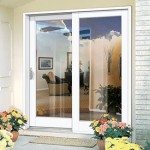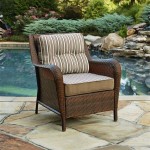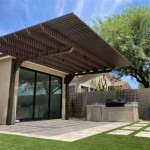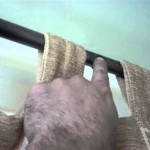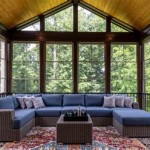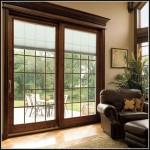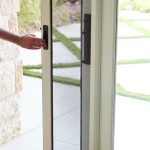Selecting the Optimal Shades for Patio Sun Control
Outdoor living spaces, particularly patios, offer a valuable extension of the home, providing areas for relaxation, entertainment, and dining. However, the enjoyment of these spaces can be significantly hampered by excessive sun exposure and heat. Effectively managing sunlight and its associated heat is crucial for creating a comfortable and usable patio environment. Shades for patios provide a practical and aesthetically pleasing solution to mitigate these challenges, offering protection from the sun's harmful UV rays, reducing glare, and contributing to a cooler, more enjoyable outdoor experience. The selection of appropriate patio shades involves considering various factors, ranging from the type of shade material and design to the specific needs and aesthetic preferences of the homeowner.
The primary function of patio shades is to control the amount of sunlight entering the space. This control is not merely about blocking light entirely; it's about managing it to create a comfortable and visually appealing environment. Different individuals have varying sensitivities to sunlight, and the intensity of the sun can fluctuate throughout the day and across seasons. Therefore, the ideal patio shade should offer a degree of adjustability to accommodate these variations. Some shades are designed to completely block sunlight, while others filter it, allowing a soft, diffused light to permeate the space. The choice between these options depends largely on the intended use of the patio and the desired ambiance.
Beyond the control of sunlight, effective patio shades also contribute to temperature regulation. Direct sunlight striking a patio surface can significantly raise the surrounding temperature, making the space uncomfortably hot. Shades reduce the amount of solar radiation absorbed by the patio, leading to a cooler environment. This is particularly important in warmer climates where extended periods of high temperatures can render patios unusable during certain times of the day. The material of the shade plays a crucial role in its ability to regulate temperature; darker fabrics tend to absorb more heat, while lighter, reflective fabrics are more effective at deflecting solar radiation. Moreover, some shade materials are designed with breathable weaves that allow air to circulate, further enhancing cooling.
Considering the aesthetic impact of patio shades is equally important. Shades are not merely functional accessories; they are visible elements that contribute to the overall appearance of the outdoor space. A well-chosen shade can complement the architectural style of the home and enhance the visual appeal of the patio. Shades are available in a wide range of colors, patterns, and designs, allowing homeowners to customize their outdoor space to reflect their personal style. The design of the shade itself, whether it's a retractable awning, a roller shade, or a set of stylish curtains, can also significantly impact the aesthetic of the patio. Therefore, the selection of patio shades should involve a careful consideration of both their functional and aesthetic properties.
Understanding Different Types of Patio Shades
The market offers a diverse range of patio shade options, each with its unique characteristics and advantages. Understanding these different types is crucial for making an informed decision that aligns with specific needs and preferences. Among the most common types are retractable awnings, roller shades, shade sails, and outdoor curtains. Each of these options provides a different approach to sun control, offering varying levels of adjustability, durability, and aesthetic appeal.
Retractable awnings are a popular choice for patios, offering a flexible and convenient way to control sunlight. These awnings can be extended or retracted as needed, allowing homeowners to adjust the amount of shade depending on the time of day and weather conditions. Retractable awnings are typically made from durable, weather-resistant fabrics and are available in a variety of colors and styles. They can be manually operated or motorized for added convenience. A major advantage of retractable awnings is their ability to provide complete shade when extended and to allow full sunlight when retracted, offering maximum control over the patio environment.
Roller shades are another common option for patio sun control. These shades are typically mounted to the patio structure and can be raised or lowered to adjust the amount of sunlight entering the space. Roller shades are available in a variety of materials, including solar screens, which filter sunlight while maintaining visibility, and blackout fabrics, which completely block sunlight. Roller shades are often a more budget-friendly option compared to retractable awnings, and they offer a clean, minimalist aesthetic. The ease of operation and the relatively simple installation process make roller shades a popular choice for many homeowners.
Shade sails offer a more contemporary and architectural approach to patio sun control. These sails are typically made from triangular or rectangular pieces of fabric that are stretched between multiple anchor points, creating a shaded area. Shade sails can be arranged in various configurations to provide different levels of shade and to create interesting visual effects. They are often made from durable, weather-resistant materials and are available in a wide range of colors. Shade sails are a particularly good option for larger patios or outdoor spaces where a more permanent shading solution is desired. Their unique design adds a distinct visual element to the outdoor space.
Outdoor curtains provide a softer and more versatile approach to patio sun control. These curtains are typically made from lightweight, weather-resistant fabrics and can be hung from a variety of structures, such as pergolas or existing patio covers. Outdoor curtains can be easily opened or closed to adjust the amount of sunlight entering the space, and they can also provide privacy and protection from wind. They are available in a wide range of colors, patterns, and styles, allowing homeowners to create a personalized and inviting outdoor space. Outdoor curtains are often a more affordable option compared to other types of patio shades, and they offer a flexible and adaptable solution for sun control.
Factors to Consider When Choosing Patio Shade Materials
The material of the patio shade plays a critical role in its performance, durability, and aesthetic appeal. Different materials offer varying levels of sun protection, weather resistance, and visual characteristics. Selecting the appropriate material is essential for ensuring that the patio shade effectively meets the specific needs and preferences of the homeowner. Key factors to consider when choosing patio shade materials include UV protection, durability, weather resistance, and aesthetic considerations.
UV protection is a primary consideration when selecting patio shade materials. Prolonged exposure to UV radiation can damage furniture, fade fabrics, and pose health risks to individuals spending time on the patio. Therefore, the ideal shade material should offer a high level of UV protection, blocking or filtering harmful UV rays. Some materials are specifically treated with UV inhibitors to enhance their protective capabilities. The level of UV protection provided by a material is typically indicated by its Ultraviolet Protection Factor (UPF) rating. Materials with higher UPF ratings offer greater protection from UV radiation.
Durability is another crucial factor to consider when choosing patio shade materials. Patio shades are exposed to the elements year-round, including sun, rain, wind, and temperature fluctuations. Therefore, the material should be durable enough to withstand these conditions without deteriorating or fading. Materials such as acrylic fabrics, polyester fabrics, and vinyl-coated fabrics are known for their durability and weather resistance. The construction and stitching of the shade are also important factors that contribute to its overall durability. Reinforced seams and high-quality stitching can help prevent tearing and fraying.
Weather resistance is closely related to durability, but it encompasses a broader range of environmental factors. Patio shade materials should be resistant to water damage, mold, mildew, and fading. Water-resistant materials will prevent rain from soaking through the shade, while mold- and mildew-resistant materials will prevent the growth of these organisms in humid environments. Fade-resistant materials will maintain their color and appearance over time, even with prolonged exposure to sunlight. The specific weather conditions in the region should be considered when selecting patio shade materials. For example, in areas with frequent rainfall, water-resistant materials are essential.
Aesthetic considerations also play a significant role in the selection of patio shade materials. The material should complement the overall aesthetic of the patio and the home. Shade materials are available in a wide range of colors, patterns, and textures, allowing homeowners to customize their outdoor space to reflect their personal style. The material should also be visually appealing and enhance the overall ambiance of the patio. For example, lighter-colored materials can create a brighter and more airy feel, while darker-colored materials can create a more intimate and secluded atmosphere. The texture of the material can also contribute to the overall visual effect.
Installation and Maintenance of Patio Shades
Proper installation and regular maintenance are essential for ensuring the longevity and optimal performance of patio shades. Incorrect installation can compromise the functionality of the shade and potentially damage the patio structure. Regular maintenance, such as cleaning and inspection, can help prevent damage and extend the lifespan of the shade. The specific installation and maintenance requirements will vary depending on the type of shade and the materials used.
The installation process for patio shades typically involves securing the shade to the patio structure, such as a wall, post, or pergola. The specific hardware and techniques used will depend on the type of shade and the materials used in its construction. For example, retractable awnings typically require professional installation to ensure proper alignment and secure attachment to the building. Roller shades can often be installed by homeowners, but it is important to follow the manufacturer's instructions carefully. Shade sails require careful planning and precise installation to ensure that the fabric is properly tensioned and securely anchored.
Regular cleaning is an important part of maintaining patio shades. Dust, dirt, and debris can accumulate on the shade over time, reducing its appearance and potentially damaging the material. The frequency of cleaning will depend on the environment and the level of exposure to dirt and pollutants. Generally, it is recommended to clean patio shades at least once a year, or more frequently if needed. The cleaning process typically involves using a mild detergent and water to gently scrub the shade. It is important to avoid using harsh chemicals or abrasive cleaners, as these can damage the material. The shade should be thoroughly rinsed with clean water and allowed to dry completely before being retracted or stored.
Regular inspection of patio shades is also important for identifying potential problems and preventing damage. The shade should be inspected for signs of wear and tear, such as tears, rips, or fraying. The hardware and attachments should also be inspected for signs of rust, corrosion, or loosening. Any problems identified during inspection should be addressed promptly to prevent further damage. For example, loose screws should be tightened, and torn fabric should be repaired or replaced. Regular maintenance can help extend the lifespan of patio shades and ensure that they continue to provide optimal sun protection.
Proper storage of patio shades during the off-season is also important for preventing damage. If the shade is not in use during the winter months or other extended periods, it should be properly stored to protect it from the elements. Retractable awnings should be retracted and covered with a protective cover. Roller shades should be rolled up and stored in a dry place. Shade sails should be removed from their anchor points and stored in a weatherproof container. Proper storage can help prevent damage from rain, snow, wind, and sun, extending the lifespan of the patio shade.

Keystone Fabrics Outdoor Roller Patio Sun Shade 6ft Wide Beige Com

Oasis 2600 Patio Shades Insolroll

Outdoor Shades Window The Home Depot

Exterior Shades Screenmobile

26 Patio Shade Ideas To Help You Stay Cool Timbertech

Shade Sails An Easy Diy Guide To Installing Your Own Reviewed

Patio Cover Ideas The Home Depot

Outdoor Solar Shades For Your Patio From Innuwindow

Outdoor Porch Shade Ideas Screenmobile

Patio Shades Sun Outdoor And Roller From Insolroll At The Blind Guys Near Tucson Oro Valley Marana Green Casas Adobes Sahuarita Vail Az
Related Posts

